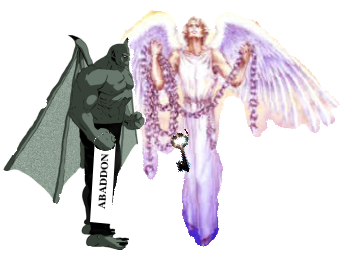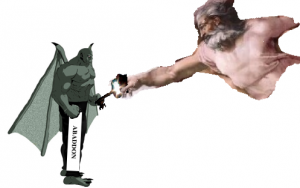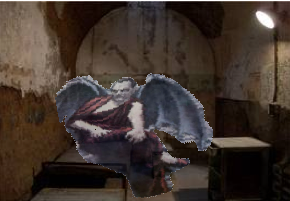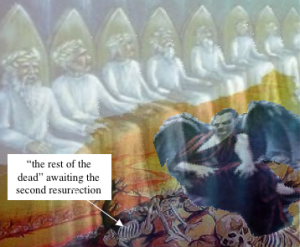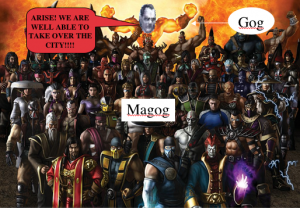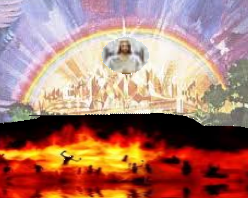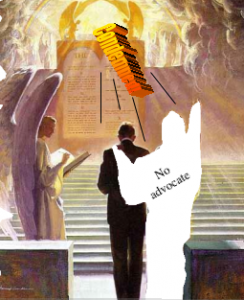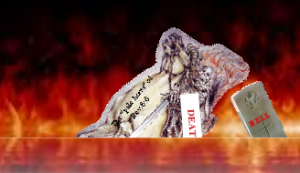Verse 1: And I saw an angel come down from heaven, having the key of the bottomless pit and a great chain in his hand.
This angel now has “the key of the bottomless pit,” the same “key” given the “star” who fell “from heaven unto the earth” (Revelation 9:1) who is “the angel of the bottomless pit, whose name . . . is Abaddon” or “Apollyon” (Revelation 9:11) the destroyer. Unless we are willing to concede the angel holding this “key” is the devil, we must conclude that the “key,” [1] representing power and authority, had, somehow, changed hands from Abaddon/Apollyon to a heavenly angel.
Indeed, it did change hands when “the second woe [was] past; and . . . the third woe [came] quickly.” That was when: “The kingdoms of this world” became God’s as He took to Himself His “great power” (Revelation 11:14, 15, 17) [2] represented by this “key” that had temporarily been turned over to Satan when the “four winds” (Revelation 7:1) were released, making him “the angel of the bottomless pit” (Revelation 9:11).
In effect, that transfer of power happened when Jesus “took the censer, and filled it with fire of the altar, and cast it into the earth” (Revelation 8:5), denoting the end of His priestly ministry in the heavenly sanctuary and the end of probationary time, accompanied by the release of the “four winds” representing the destructive power of Satan. Thus, the metaphoric “bottomless pit,” first mentioned in Revelation 9:1, is, in general, symbolic of post probationary time. [3]
The “chain” in the angel’s hand is not literal, but significant of the fact that Satan now has nothing more to do than to view the pathetic remains of the “remnant [that] were slain with the sword of him that sat upon the [white] horse” (Revelation 19:21). Now, he has been committed to solitary confinement with “the slain of the LORD” strewn from “one end of the earth even unto the other end of the earth: they shall not be lamented, neither gathered, nor buried; they shall be dung upon the ground” (Jeremiah 25:33).
Verse 2: And he laid hold on the dragon, that old serpent, which is the Devil, and Satan, and bound him a thousand years,
There are a number of symbolic names for “the Devil, and Satan” in the book of Revelation. Not only is he listed as a “dragon,” and a “great red dragon” (Revelation 12:3), he is also called a “star” (Revelation 9:1) and a “beast,” when “he ascended “out of the bottomless pit” (Revelation 11:7). Additionally, he is named “Abaddon” or “Apollyon” and disguised as “Wormwood” (Revelation 9:11; 8:10, 11) leading his followers, under both deceptions, “into perdition,” or utter ruin. He is identified as the rider of the “horse that was red” who takes “peace from the earth” (Revelation 6:4), and as the rider of the “pale horse,” he is given the name “Death” (Revelation 6:8).
Twice, this “great dragon . . . called the Devil, and Satan” is called “old” (Revelation 12:9, 20:2), and probably the oldest created being in the universe, perhaps millions if not billions of years old, suggesting “he was old enough to know better!”
To us, “a thousand years of time” [4] seems preposterously long, but to Satan, from his perspective of time while he busies himself in the fevered activity of attempting to frustrate God’s purposes, it probably seems quite brief. However, when silence descends, with nothing more to do, his suffering will be intense. Time, in spite of his old age, will drag.
He was not created a Devil. He, like all other angels and men, were created with the power of choice. In fact, he was “perfect in [his] ways from the day that [he was] created, till iniquity was found in [him]” (Ezekiel 28:15). In other words, “the Devil, and Satan” created himself. He chose to be a Devil. God was not responsible for his choice or even the choices of all the other angels who “were cast out with him” (see Revelation 12:9).
Verse 3: And cast him into the bottomless pit, and shut him up, and set a seal upon him, that he should deceive the nations no more, till the thousand years should be fulfilled: and after that he must be loosed a little season.
This is the seventh and last time the figurative “bottomless pit” is mentioned (see Revelation 9:1, 2, 11; 11:7; 17:8; 20:1, 3). White explains “the expression ‘bottomless pit’” in this setting represents “the earth in a state of confusion and darkness . . . evident from other scriptures . . . Looking forward to the great day of God, the prophet Jeremiah declares: ‘I beheld the earth, and, lo, it was without form, and void; and the heavens, and they had no light. I beheld the mountains, and, lo, they trembled, and all the hills moved lightly. I beheld, and, lo, there was no man, and all the birds of the heavens were fled. I beheld, and, lo, the fruitful place was a wilderness, and all the cities thereof were broken down.’ [Jer. 4:23-27].” [5]
However, the fallen angel was “given the key of the bottomless pit” during which time “many men wished to die, but were unable” (Revelation 9:1-11). Also, recall that “they that dwell [or live] upon the earth were celebrating (Revelation 11:10), even after “the beast [had ascended] out of the bottomless pit” (Revelation 11:7). The beast’s ascension from the “bottomless pit” is also referred to later on (Revelation 17:8). Consequently, the only element that the earlier mention of the “bottomless pit” (Revelation 9:1, 2, 11; 11:7, 17:8) has in common with this chapter is that it is figurative of post probationary time while men are still alive. [6] Now, in this chapter and according to Revelation 19:20, 21, they are all dead. But, as this verse indicates, Satan will be “loosed a little season” [7] suggesting a little time of liberty from solitary confinement before his execution.
But why was a “seal” set upon him, if he was already “bound” with “a great chain (Verses 1, 2)? The Commentary remarks that the “seal” indicates “Satan will be effectively restrained for the period indicated.” [8]
Verse 4: And I saw thrones, and they sat upon them, and judgment was given unto them: and I saw the souls of them that were beheaded for the witness of Jesus, and for the word of God, and which had not worshipped the beast, neither his image, neither had received his mark upon their foreheads, or in their hands; and they lived and reigned with Christ a thousand years.
While Verses 1-3 depict an earthly scene where Satan is “bound,” those given “judgement” must be indicative of “much people in heaven” who were rejoicing before “God that sat on [His] throne” (Revelation 19:1-4). “They” have been “made . . . kings and priests unto God and his Father [and] shall reign on the earth” (Revelation 1:6; 5:10) [9] later on “when the thousand years are expired” (Verse 7).
In the meantime, here in heaven, they occupy “thrones” where they are given “power over the nations” to “rule . . . with a rod of iron: as the vessels of a potter shall they be broken to shivers: even as [Jesus] received of [His] Father” (Revelation 2:26, 27) after He was “caught up unto God, and to his throne” (Revelation 12:5).
It could be now that they exclaim: “How art thou fallen from heaven, O Lucifer, son of the morning! how art thou cut down to the ground, which didst weaken the nations! For thou hast said in thine heart, I will ascend into heaven, I will exalt my throne above the stars of God: I will sit also upon the mount of the congregation, in the sides of the north: I will ascend above the heights of the clouds; I will be like the most High. Yet thou shalt be brought down to hell to the sides of the pit. They that see thee shall narrowly look upon thee, and consider thee, saying, Is this the man that made the earth to tremble, that did shake kingdoms; that made the world as a wilderness, and destroyed the cities thereof; that opened not the house of his prisoners?” (Isaiah 14:12-16).
At this point, of course, the “nations” will indeed have already been “broken to shivers” when the last “remnant were slain with the sword of him that sat upon the [white] horse” (Revelation 19:21). So, how can these people who are already in heaven break them “to shivers?” Obviously to assess, then ratify God’s fairness in His dealings with such things as the “the beast, and the kings of the earth, and their armies [who had] gathered together to make war against him that sat on the [white] horse, and against his army” (Revelation 19:19).
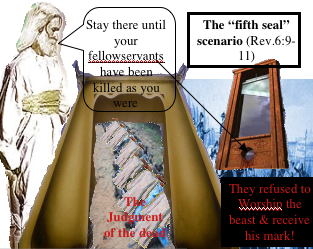
Among the heavenly gathering, we see a particular group of the saved called “the souls of them that were beheaded.” Of course, thousands of martyrs have been “beheaded” throughout time, but this group is special. They were killed because they refused to worship “the beast . . . image” and refrained from receiving “his mark upon their foreheads, or . . . hands.”
This is a scenario that is yet to take place because the “image” and “mark” will be enforced by the earth “beast” who will begin to speak “as a dragon” causing “all . . . to receive a mark in their right hand, or in their foreheads.” If they refuse, they will be prohibited from buying or selling and even “killed” (Revelation 13:15).
Therefore, these are the “fellowservants” and “brethren” of the “souls” John “saw under the altar” when the “fifth seal” was “opened” (Revelation 6:9-11). Those “souls” were instructed to “rest yet for a little season” until these “fellowservants” and “brethren” would be “killed.” That killing spree must take place during the “ten days” of “tribulation” just before the close of probation when those who say “they are Jews, and are not, but are the synagogue of Satan” put them on trial and cast them “into prison.” Yet they are “faithful unto death.” (Revelation 2:9, 10) [10]
Now, in the first scene depicted under this verse, we see the “souls” and “fellowservants,” who had been resurrected, join with all the others in the work of judgment God assigns them. Even though they were martyred, they had just passed the test the “people of God must have before they are sealed” [11] when the “fifth seal” is opened (Revelation 6:9-11).
This illustration is shocking, not only because of the manner of execution, with no trial by jury, but because of the callous behavior of the bystanders, as well as the executioner. It depicts how unpopular and life threatening it will be to take a stand for truth when the “beast, image and mark” test will actually be fulfilled. This will be “the hour of temptation which shall come upon all the world, to try them that dwell upon the earth.” (Revelation 3:10). Very soon after this, the bystanders and the mockers will themselves die, while the victims will ultimately live and reign “with Christ a thousand years!”
Verse 5: But the rest of the dead lived not again until the thousand years were finished. This is the first resurrection.
The “rest of the dead” are “the wicked dead, those who from the beginning of time have gone into Christless graves and those who have perished at the second coming of Christ” (Revelation 6:14-17). This “first resurrection” refers to the one mentioned in Verse 4. [12]
Verse 6: Blessed and holy is he that hath part in the first resurrection: on such the second death hath no power, but they shall be priests of God and of Christ, and shall reign with him a thousand years.
They are “blessed” or “happy” [13] and “holy” because they, even like the 144,000, are “without fault before the throne of God” [14] They arise “in the first resurrection,” implying a “second” resurrection is to follow, otherwise a “second death” would be impossible.
“It is at midnight that God manifests his power for the deliverance of his people. The sun appears, shining in its strength. Signs and wonders follow in quick succession. The wicked look with terror and amazement upon the scene, while the righteous behold with solemn joy the tokens of their deliverance. Everything in nature seems turned out of its course. The streams cease to flow. Dark, heavy clouds come up, and clash against each other. In the midst of the angry heavens is one clear space of indescribable glory, whence comes the voice of God like the sound of many waters, saying, ‘It is done.’ (Revelation 16:17).” [15]
“Graves are opened, and ‘many of them that sleep in the dust of the earth . . . awake, some to everlasting life, and some to shame and everlasting contempt.’ (Daniel 12:2) All who have died in the faith of the third angel’s message come forth from the tomb glorified, to hear God’s covenant of peace with those who have kept his law. ‘They also which pierced Him,’ (Revelation 1:7), those that mocked and derided Christ’s dying agonies, and the most violent opposers of his truth and his people, are raised to behold him in his glory, and to see the honor placed upon the loyal and obedient.” [16]
“The voice of God is heard from Heaven, declaring the day and hour of Jesus’ coming, and delivering the everlasting covenant to his people.” [17]
“Soon there appears in the east a small black cloud, about half the size of a man’s hand. It is the cloud which surrounds the Saviour, and which seems in the distance to be shrouded in darkness. The people of God know this to be the sign of the Son of man. . . . [and] Jesus rides forth as a mighty conqueror.” [18]
“Amid the reeling of the earth, the flash of lightning, and the roar of thunder, the voice of the Son of God calls forth the sleeping saints . . . All come forth from their graves the same in stature as when they entered the tomb. Adam, who stands among the risen throng, is of lofty height and majestic form, in stature . . . all arise with the freshness and vigor of eternal youth.” [19]
Consequently, the righteous will die only once, although some will never die and be translated. On the other hand, most of the wicked will die twice, but some, such as those who actually “pierced Him,” will die three times: after the first death, after the “first resurrection,” then after the “second resurrection” that John identifies as “the second death!”
Verse 7: And when the thousand years are expired, Satan shall be loosed out of his prison,
This is the sixth and last time the “thousand years” are mentioned in Revelation, making it the second, most frequently mentioned time prophecy in the Bible! [20] Are the “thousand years” to be understood literally, or as prophetic day-for-a-year time?
The Commentary remarks: “Some commentators take this to be prophetic time, that is, 360,000 literal years, basing their interpretation on the fact that these verses are symbolic, and that therefore the time period must be symbolically interpreted. Others point out that this prophecy contains a mixture of literal elements, and that therefore it is not necessary to understand the expression symbolically. This commentary takes the position that the thousand years are literal.” [21]
There is good support for that “position” where Christ, depicted as a “mighty angel,” swore “that there should be time no longer” (Revelation 1:6) “This time, which the angel declares with a solemn oath, is not the end of this world’s history, neither of probationary time, but of prophetic time, which should precede the advent of our Lord. That is, the people will not have another message upon definite time. [22] After this period of time, reaching from 1842 to 1844, there can be no definite tracing of the prophetic time. The longest reckoning reaches to the autumn of 1844.” [23] [24]
As the Commentary implies, by alluding to those who interpret the “thousand years” as “360,000 literal years,” “prophetic time” is the “year-day principle.” Coupled with White’s quote, there will be no more “prophetic time” or “year-days” after 1844, it is clear that the “thousand years” should be interpreted as literal time.
Some, believing there are no more time prophecies after 1844, and struggling with how to apply the “thousand years” of future, literal time, have decided the “thousand years” cannot be called a “time prophecy,” But, that argument can be dismissed out of hand. Consider that the Greek word for “years” is from “etos,” [25] meaning “year” in the literal sense. Therefore, the “thousand years” is definitely a “time prophecy.”
Instead of “definite time,” the “thousand years” should be categorized as a “thousand years” of “indefinite time” because the exact beginning point is unknown. It will become known only when “The voice of God is heard from Heaven declaring the day and hour of Jesus’ coming, [26] and delivering the everlasting covenant to his people.” [27] Then, and only then will it become “definite time.”
Satan being “loosed out of his prison” implies the second resurrection, called the “second death” (Verse 6), has taken place. [28] Therefore, in spite of being resurrected to life in the second resurrection, the wicked are still in “the bottomless pit.” They are resurrected to life only to prove to the onlooking universe, by their behavior, that they are unworthy of eternal life. Therefore, eternal extinction is the only solution. Consequently, the “bottomless pit” metaphor still applies and should be understood to represent post probationary time.
In effect, the “key,” Satan, the fallen “star,” was given that made him “the [temporary] angel of the bottomless pit” (Revelation 9:11) when the “four winds” were released, that was taken back when the “seventh” trumpet bearing “angel sounded,” is again returned to him. The saints, who are watching breathlessly, wait to see what he will do with his newfound freedom, wondering, perhaps, that the thousand-year period of solitary confinement might have produced a change in his attitude.
Verse 8: And shall go out to deceive the nations which are in the four quarters of the earth, Gog and Magog, to gather them together to battle: the number of whom is as the sand of the sea.
This is God’s prediction. The “thousand years” of solitary confinement will produce zero change in Satan’s character and behavior. So, what is the point of going through all of this? It is because, even for the faithful angels in heaven, let alone the saints on earth, “seeing is believing.” God understands this, and, in order to insure that “affliction shall not rise up the second time” (Nahum 1:9), He has to allow Satan, once and for all, to demonstrate there is absolutely no alternative to the extermination of Satan and his followers.
If God dealt with Satan prematurely, even at the end of the pre-millennial executive judgment, [29] somebody, even among the host of the faithful angels, would, eventually, be sure to question God’s fairness. God, in His infinite wisdom, knows this final demonstration will amply satisfy all the doubts about His justice that could possibly arise throughout the ceaseless ages of eternity, even before they are asked!
So, Satan, without any thought of the misery and isolation he suffered during the “thousand years,” goes “out to deceive the nations” that have just been resurrected. Here, the “nations” are given a strange name: “Gog and Magog,” representing “Satan and his hosts at the end of the millennium.” [30] They “represent the hosts of the unsaved of all ages who come forth in the second resurrection.” [31]
Verse 9: And they went up on the breadth of the earth, and compassed the camp of the saints about, and the beloved city: and fire came down from God out of heaven, and devoured them.
With this assault on the “camp of the saints,” the “little season” (Verse 3), when “the Devil, and Satan” were cut lose, has come to an end.
During the previous “thousand years,” Satan’s army, “Magog,” was lying strewn about the earth with most of their decomposed bodies moldering, and thus, oblivious. Now, in spite of being resurrected by God’s power, they still “bear the traces of disease and death . . .” Worse yet, they “come forth, with the same enmity to Christ, and the same spirit of rebellion.” Consequently, they “resume the [same] current of their thoughts just where it ceased.” Evidently, they realize they had been unconscious in the grave where death found them, but with no idea how they were resurrected until Satan assures “them that his power has brought them forth from their graves, and that he is about to rescue them from the most cruel tyranny.” [32]
He had just spent the past “thousand years” mulling over his past and being more fully aware of this prophecy than most Christians. He knew, based on Verse 8, that the “nations” would be restored to him. Instead of taking Verses 14 and 15 into consideration that depict his destruction, he dismissed them and concentrated on what his next move would be when the hour of freedom would arrive.
One glimpse of the vast multitude lying before him reassures him he cannot fail. Any thought of turning back is swept away by the same pride he had been cultivating for, perhaps, millions of years. “This multitude,” he might think, “is devoted to me, and there is no limit to what I can do with them.” Thus, the attack, the plans of which could take a number of post millennial years, is launched.
When Gog gives “the order to advance . . . the countless host moves on―an army such as was never summoned by earthly conquerors, such as the combined forces of all ages since war began on the earth could never equal . . .” Then, “By command of Jesus, the gates of the New Jerusalem are closed . . . [33] This suggests the gates had been standing open throughout the “little season” (Verse 3) and God was prepared to allow entrance to anybody, even during the time Gog and Magog were preparing for battle with “skillful artisans” constructing “implements of war,” and “military leaders, famed for their success,” were marshalling “the throngs of warlike men into companies and divisions.” [34]
Nevertheless, in spite of the intense preparation being made for war, it seems none of Satan’s intelligence corps considered infiltrating the city to spy out the land of the saints, and for good reason. Going back to the second resurrection, just before the time the wicked were called forth from the grave, “Jesus leaves the city surrounded by the redeemed host” [35] and then “calls forth the wicked dead.” [36] Therefore, the redeemed, instead of remaining behind the walls of the holy city, follow Jesus outside the city and witness the second resurrection first-hand! Except for a few, whom God mercifully “permits . . . to be as if he had not been,” all the wicked who ever lived from the beginning to the end of earth’s history will arise right at their feet. But the wicked do not greet the life giver with joy. Instead “they flee to hide from the presence of the King of kings and Lord of lords.” [37] Such fear persists throughout their war preparation, and none have the least inclination to enter the open doors of the city.
Thus, is demonstrated that “It is no arbitrary decree on the part of God that excludes the wicked from heaven; they are shut out by their own unfitness for its companionship. The glory of God would be to them a consuming fire. They would welcome destruction, that they might be hidden from the face of Him who died to redeem them.” [37a] The same attitude was demonstrated during the second coming when the wicked called for “the mountains and rocks” to “fall on” them and hide them “from the face of him that sitteth on the throne . . .” (Revelation 6:16).
Quite possibly, during the time Jesus performs the second resurrection, in the presence of the saints, they will converse with lost family members, past friends and enemies, even those who were responsible for some of their (first) deaths. They might speak with them pointing to the holy city, which has been their home for the last thousand years and tell them what a wonderful place it is to live.
To the wicked, it seems but a moment since they died, and in astonishment and utter disbelief they view the home of the saved. They are attracted to it, but when “Jesus . . . accompanied by all the saints, again go to the City . . . bitter lamentations and wailings of the doomed wicked fill the air.” [38] Even though they would love to go in, they are terrified of the Saviour and are seized with an unnamed fear of His presence. As saddened as the saints are by this attitude, it is clear to them that the fault lies entirely with the wicked. Jesus did everything He could possibly do to get them to accept him, but they refused. Their exclusion from the city is their own choice. In fact, if they were forced “into the company of the pure and holy [they would be] exceedingly miserable” [39] and heaven would be hell for them. Consequently, the saints must bid their lamenting loved ones a tearful farewell.
This is the reason for the final post millennial scenario when Gog is freed from bondage. It is to eradicate, once and for all, any lingering doubt about the fairness of God’s forthcoming administration of justice.
We are not told how much time elapses between the second resurrection and the time the wicked lay siege to the holy city. It seems unlikely that the saints will have any desire to mingle with the wicked as they prepare for the onslaught. Nevertheless, they probably witness, in stunned amazement, how Gog quickly deceives the multitude as he passes among them. He makes “the weak strong and inspires all with his own spirit and energy.” [40]
After “Jesus closes the gates of the city and this vast army surround it and place themselves in battle array . . . Jesus and all the angelic host . . . and all the saints ascend to the top of the wall of the city. Jesus speaks with majesty and says, Behold, ye sinners, the reward of the just! And behold ye my redeemed the reward of the wicked!” [41]
Then “in the presence of the assembled inhabitants of earth and Heaven the final coronation of the Son of God takes place . . . invested with supreme majesty and power, the King of kings pronounces sentence upon the rebels . . . As soon as the books of record are opened, and the eye of Jesus looks upon the wicked, they are conscious of every sin which they have ever committed . . . all appear as if written in letters of fire . . . Satan, his angels, and his subjects have no power to turn from the picture . . . Each actor recalls the part which he performed . . . Satan seems paralyzed as he beholds the glory and majesty of Christ . . . Memory recalls the home of his innocence and purity” and now “he sees only failure and ruin . . . With all the facts of the great controversy in view, the whole universe, both loyal and rebellious, with one accord declare: ‘Just and true are Thy ways, Thou King of saints’ . . .
“Notwithstanding that Satan has been constrained to acknowledge God’s justice, and to bow to the supremacy of Christ, his character remains unchanged . . . Filled with frenzy, he determines not to yield the great controversy. The time has come for a last desperate struggle . . . He rushes into the midst of his subjects, and endeavors to inspire them with his own fury, and arouse them to instant battle . . . His power is at an end. The wicked are filled with the same hatred of God that inspires Satan; but they see that their case is hopeless, that they cannot prevail against Jehovah. Their rage is kindled against Satan and those who have been his agents in deception, and with fury of demons they turn upon them.” [42]
At this point “fire [comes] down from God out of heaven, and devour[s] them.”
Verse 10: And the devil that deceived them was cast into the lake of fire and brimstone, where the beast and the false prophet are, and shall be tormented day and night for ever and ever.
In contrast to the time “the devil,” known as “Wormwood, Abaddon” or “Apollyon” (Revelation 8:10, 11; 9:11), who was previously spared destruction, but rather thrown into solitary confinement (Verse 2), now with the proceedings of the post millennial judgment complete, God’s just sentence, committing him to eternal extinction, is executed.
Note, according to the way this verse seems to read, “the beast and the false prophet are” already in this “lake of fire.” They had been “cast alive into” it during the pre-millennial time of the second trumpet, with “the remnant” being “slain with the sword of him that sat upon the [white] horse” (Revelation 19:20, 21). But, with a “thousand years” separating the pre-millennial time of the second trumpet, depicted as “a lake of fire burning with brimstone,” and the post millennial “lake of fire,” also burning with “brimstone,” it is clear they are two entirely different fires. [42a]
In contrast to the first “fire,” with the “remnant” being “slain with the sword,” in the second, there is no surviving “remnant.” All the wicked, according to the next few verses, will be consumed in the second “fire.” This means that the penalty suffered by the “beast” and the “false prophet” in the first fire will be the same penalty visited upon all the wicked in the second “fire.” Therefore, those who were “cast alive” into the first “fire” will, apparently, be resurrected to be cast into the “second.” Thus, we see the final reward of the “beast power,” whose “sins have reached unto heaven, and God hath remembered her iniquities. Reward her even as she rewarded you, and double unto her double according to her works: in the cup which she hath filled fill to her double” (Revelation 18:5, 6).
Verse 11: And I saw a great white throne, and him that sat on it, from whose face the earth and the heaven fled away; and there was found no place for them.
Here, John backtracks from the “lake of fire” scenario (Verse 10) to this majestic judgment scene which takes place just before the fire erupts, directly from the hand of God, causing ‘the earth and heaven” to fly away [43] or to be enveloped in flame with “no place for” the wicked. In other words, they could not escape from God’s righteous indignation.
Prior to that, just after Satan had given “the order to advance . . . and the countless host moves on . . . the gates of the New Jerusalem are closed . . .” Then “Christ again appears to the view of his enemies. Far above the city, upon a foundation of burnished gold, is a throne, high and lifted up. Upon this throne sits the Son of God, and around him are the subjects of his kingdom.” [44]
“Nearest the throne are those who were once zealous in the cause of Satan, but who, plucked as brands from the burning, have followed their Saviour with deep, intense devotion. Next are those who perfected Christian characters in the midst of falsehood and infidelity, those who honored the law of God when the Christian world declared it void, and the millions, of all ages, who were martyred for their faith. And beyond is the ‘great multitude, which no man could number, of all nations, and kindreds, and people, and tongues’ . . . ‘before the throne, and before the Lamb, clothed with white robes, and palms in their hands.’ Revelation 7:9.” [45]
Verse 12: And I saw the dead, small and great, stand before God; and the books were opened: and another book was opened, which is the book of life: and the dead were judged out of those things which were written in the books, according to their works.
This is “the time of the dead, that they should be judged” (Revelation 11:18). It is the executive judgment that succeeds the Investigative Judgment which began when Jesus “came and took the book” (Revelation 5:7). There are at least three stages of the executive judgment: pre-millennial, millennial and post millennial.
The pre-millennial executive judgment began when Jesus “took the censer, and filled it with fire of the altar, and cast it into the earth” (Revelation 8:5) followed by seven trumpet events. As we have learned, the first six trumpet events demonstrated to the world and the universe what Satan’s unrestrained rule was like. The final series of events called “the third woe” (Revelation 11:14) amounting to “seven last plagues,” brought Satan’s pre-millennial rule to an end.
Following the last plague, when “there fell upon men a great hail out of heaven” and men called for “the rocks and mountains” to “fall on [them], and hide [them] from the face of him that sitteth on the throne,” the saints, who had been carried to heaven by “the Lamb,” were given “thrones, and they sat upon them” and “judgment was given unto them” for a “thousand years” to examine the “books” containing the open records of the wicked “dead, small and great.” This occurs during the millennial phase of the executive judgment, that could be called the “assessory judgment.” The wicked “stand before God,” metaphorically, during the thousand years while their records are being examined. Then, during the post millennial judgment, they, literally, “stand before God.” The “books of record are opened, and the eye of Jesus looks upon the wicked, they are conscious of every sin which they have ever committed. They see just where their feet diverged from the path of purity and holiness, just how far pride and rebellion have carried them in the violation of the law of God. The seductive temptations which they encouraged by indulgence in sin, the blessings perverted, the messengers of God despised, the warnings rejected, the waves of mercy beaten back by the stubborn, unrepentant heart―all appear as if written in letters of fire.” [46]
Both the pre-millennial and post millennial executive judgments are two phased. During the seven-trumpet pre-millennial executive judgment, Satan is given free hand with the wicked during the first six trumpets, followed by God Himself taking control when He pours out the seven last plagues of the seventh trumpet/third woe. The post millennial executive judgment is similar. As we have seen in this chapter, following the second resurrection, Satan is again given a free hand with the wicked. Then God sends the “fire . . . out of heaven” that “devoured them” (Verse 9).
The wicked are temporarily given life (as implied in Verses 5 and 7) “in the second resurrection.” [47] And, although John saw them literally standing “before God” to hear the Judge’s verdict, he still called them “dead.” Therefore, they are soon to “be hurt of” death and fall under the “power” of the “second death” (Revelation 2:11; 20:6) when the sentence is executed in “the lake of fire” (Verse 10). They will remain “dead” for eternity. There is no such thing a post millennial “third resurrection,” except for a special group of the wicked whom Christ awakened “to shame and everlasting contempt” because they had actually “pierced him” (Daniel 12:2; Revelation 1:7) at His crucifixion. Those in that group will have been resurrected the third time (in “the second resurrection”) and will die for a third time in “the [post millennial] lake of fire.”
Extrapolating that thought even further, some, like those who were closely related to the “great whore” and the “false prophet” will have already been “cast alive into a [pre-millennial] lake of fire” (Daniel 7:11; Revelation 17:16; 19:20) and in the post millennial lake of fire (Verses 9, 13, 14).
Verse 13: And the sea gave up the dead which were in it; and death and hell delivered up the dead which were in them: and they were judged every man according to their works.
“These words set forth the universality of the second resurrection implied in v. 12.” [48] Note the sequence of the “second resurrection” scenario depicted in this chapter. The “thousand years” of Satan’s solitary confinement on the earth is portrayed in Verses 1 to 3, while the saints are sitting in judgment in heaven for the same “thousand years” (Verse 4). Those judged are depicted as “the rest of the dead” (Verse 5). Verse 6 compares the extreme desirability of the “first resurrection” over the “second death.” Verses 7 to 10 describe Satan being loosed and the nations of the unsaved that will be resurrected to free him from his confinement, with neither Satan nor the nations displaying any change in character. Then “fire came down from God out of heaven, and devoured them” including “the devil” together with “the beast and the false prophet.” In Verses 11-15, John takes us over the same ground in an executive judgment context.
Verse 14: And death and hell were cast into the lake of fire. This is the second death.
Here we see “death and hell” “personified” [49] as they already were where John saw “a pale horse: and his name that sat on him was Death, and Hell followed with him” (Revelation 6:8). This verse confirms that the “pale horse” and its rider will outlive the “horse that was red” that “were affrighted” (Revelation 11:13). Those represented by the “black horse” will live on forever when they receive the “white linen, white and clean” and follow the “white horse; and he that sat upon him” (Revelation 19:11, 14).
Verse 15: And whosoever was not found written in the book of life was cast into the lake of fire.
Some complain that God is cruel, even “criminal,” [50] to destroy the wicked in this manner. Why not annihilate them all in a moment without inflicting such “unnecessary” suffering? But is it really “unnecessary?” Are any of God’s dealings unnecessary? Since this devouring fire is a manifestation of “his strange (unusual, foreign, unknown) act” (Isaiah 28:21), this action is something the inhabitants of the universe have never witnessed before. For the past 7,000 years, they have seen, time after time, God’s patience stretched to the absolute limit and have frequently been tempted to accuse God of permissiveness. Like David who cried: “Why standest thou afar off, O LORD? why hidest thou in times of trouble?” (Psalms 10:1) they too must have wondered why God did not interfere with the treachery and injustice of men more often than He did!
If God’s final act of justice were manifested in such a way that made no distinction between the magnitude of each sinner’s guilt, the heavenly witnesses could easily conclude God was indifferent, uncaring and, worst of all, unjust. Although God is merciful, there is no such thing as mercy without justice. Mercy without justice can only be called “indifference.”
Because His mercy and patience were by far the most demonstrated attribute of His character throughout the history of the world, it becomes absolutely imperative that He validate the reality of His justice; that He really does care and that He was not, in any way, indifferent to the treachery, injustice and cruelty of evil men and angels.
Therefore, the “second death” will be painful to many of the wicked, if not most. Nevertheless, it will only last a relatively short time. The fire will go out and never be lit again. God “will make an utter end: affliction shall not rise up the second time;” (Nahum 1:9) but, not because the universe feels cowed into submission! God’s “strange act” will be seen as an essential component of mercy that was long overdue! After “Gog and Magog” are destroyed, and the molten earth has cooled, “One reminder alone remains: our Redeemer will ever bear the marks of His crucifixion. Upon His wounded head, upon His side, His hands and feet, are the only traces of the cruel work that sin has wrought.” [51] It will inspire love, devotion and gratitude. None will obey because they feel intimidated. Sin will be regarded with absolute revulsion because of what it cost our Creator and Redeemer! Quite likely, the record “books” that “were opened” (Verse 12) and held in “the right hand of him that sat on the throne” (Revelation 5:1) and scrutinized during the “thousand years,” will also be cast into the lake of fire and never ever referred to again. They will never again be needed!
How can we avoid the “second [forever terminal] death?” By making sure our names are written in “the book of life.” Nothing could be simpler or more desirable.
Summary of Chapter 20: This chapter, whose context is the gruesome “supper of the great God” where vultures are depicted feasting on the dead bodies of “the remnant” who were “slain with the sword of him that sat upon the [white] horse” at the end of the “third woe” or “seven last plagues,” now turns its attention to Satan who will be obliged to remain idle, and to the saved who find themselves in heaven for the next “thousand years” to assess God’s fairness for not resurrecting the wicked in the “first resurrection.” Afterwards, Satan regains an unprecedented degree of freedom when all the wicked, who ever lived from the beginning to the end of earth’s history, are restored to life. They witness the glories of the “camp of the saints” and, while they feel drawn to it, they are terrorized to be in the presence of Jesus, and, thus, in effect, flee into the arms of Satan who marshals them into a vast army called “Magog,” with himself being called “Gog.” Their attempt to capture “the beloved city” settles once-and-for-all any doubt about God’s justice in not resurrecting them in the first resurrection, and their final destruction in the post millennial lake of fire.
[1] “key” is from “kleis” (Strong’s #2807) “the keeper of the keys has the power to open and shut; a metaphor in the NT to denote power and authority of various kinds.” Jesus defines it as the power “of hell and of death” (Revelation 1:18) and the power of “David” (Jesus’ humanity) to open and shut (Revelation 3:7). A key was given temporarily to a fallen “star” (Revelation 9:1). Key/keys is found twice more, to represent the authority given the “church” (Matthew 16:18, 19) and to represent “knowledge” when Jesus was reproving the Pharisees (Luke 11:52).
[2] That “power,” as we learned in Revelation 9:1, was actually turned over to Satan when the “four winds” (Revelation 7:1-3), representing the “terrible power of Satan,” were released when the seven trumpet bearing angels began to sound (Revelation 8:6 and onwards). Note (Revelation 9:1) that the “key” “was given” ―past tense.
[3] If the term “post probationary time” is difficult to understand, it simply means time, as we know it, lingers on after the close of probation. Probationary time is what we are enjoying right now.
[4] “For a thousand years, Satan will wander to and fro in the desolate earth, to behold the results of his rebellion against the law of God. During this time his sufferings are intense. Since his fall, his life of unceasing activity has banished reflection; but he is now deprived of his power, and left to contemplate the part which he has acted since first he rebelled against the government of Heaven, and to look forward with trembling and terror to the dreadful future, when he must suffer for all the evil that he has done, and be punished for the sins that he has caused to be committed.” (The Great Controversy by E.G. White, page 660)
[5] The Great Controversy by E.G. White, pages 658, 659
[6] As an example of the mistakes that a strict Historicist application can lead to, consider this suggestion from the Commentary: “With respect to the Arabs, the bottomless pit may be thought of as representing the vast wastes of the Arabian deserts, whence these followers of Mohammed issued forth, to spread their conquests over vast areas.” (Seventh-day Adventist Bible Commentary, Vol. 7, page 791 top right column). I bring this up, not to ridicule, but as a point of constructive criticism.
[7] The duration of the “little season,” from “mikros” (Strong’s #3398) and “chronos” (Strong’s #5550) meaning “little time,” cannot be determined. But, note the same phraseology used in Revelation 6:11 where the “souls” “under the altar” were told to “rest yet for a little season, until their fellowservants . . . should be killed . . .”
[8] Seventh-day Adventist Bible Commentary, Vol. 7, page 880 (left column under “Set a Seal.”)
[9] “During the thousand years between the first and the second resurrection, the judgment of the wicked takes place. Daniel declares that when the Ancient of days came, ‘judgment was given to the saints of the Most High.’ At this time the righteous reign as kings and priests unto God. John in the Revelation says, ‘I saw thrones, and they sat upon them, and judgment was given unto them.’ ‘They shall be priests of God and of Christ, and shall reign with him a thousand years.’ It is at this time that, as foretold by Paul, ‘the saints shall judge the world.’ In union with Christ they judge the wicked, comparing their acts with the statute book, the Bible, and deciding every case according to the deeds done in the body. Satan also and evil angels are judged by Christ and his people.” (The Southern Watchman by E.G. White, 3-14-05)
[10] Remember, the churches of Smyrna and Philadelphia represent the experiences of the church during the last moments of time as well as two former periods of the Christian church. Note Acts of the Apostles by E.G. White, page 585
[11] see Manuscript Releases by E.G. White, Vol. 15, page 15; 1888 Materials by E.G. White, page 701; Review and Herald 1-11-87
[12] Seventh-day Adventist Bible Commentary, Vol. 7, page 881 (left column under “5. Rest of the dead”)
[13] “blessed” from “makarios” (Strong’s #3107) “happy” or “happier)
[14] This phrase, describing the character of the 144,000 (Revelation 14:5) encapsulated by the term “holy,” must be applicable to every person who will at last stand before the throne of God and who will occupy the “thrones” depicted in Verse 4. Faultlessness, of course, is what Christ confers upon the true believer.
[15] The Great Controversy by E.G. White, page 636, 2nd paragraph.
[16] Ibid page 637 2nd paragraph
[17] Ibid page 640 2nd paragraph
[18] Ibid pages 640, 641 (bottom of page to top of next)
[19] Ibid page 644, 2nd and 3rd paragraphs
[20] The most frequently mentioned time prophecy is the 1260 of Daniel 7:25; 9:27 (where the final week of the seventy is split into two 1260’s); 12:7; Revelation 11:2, 3; 12:6, 14 and 13:5.
[21] Seventh-day Adventist Bible Commentary, Vol. 7, page 880 (top left column under “Thousand years.”)
[22] Interestingly, the phrase “definite time” is found some 83 times in White’s writings which means there will be no more “time setting” as was done by the Millerites prior to 1844. Consider what Daniel may have understood back in 538 B.C. Having understood the beginning point of the 2300 day “mar’eh” was at “the going forth of the commandment to restore and to build Jerusalem” (Daniel 9:25), he must have considered Cyrus’ decree in 538 B.C. to be the beginning point of the 2300 days (Daniel 8:14). If he did, he would have been 80 years in error. Therefore, when Daniel received the time prophecy (Daniel 8:14), it had to be “indefinite time.” It became “definite” when William Miller came to the conclusion, retrospectively, that 457 B.C. was the actual beginning point. This is exactly how the future time prophecies of Daniel and Revelation should be understood. Their beginning points, such as the 1260, 1290 and 1335 days of Daniel 12 can only be understood retrospectively. The events outlined in the trumpet scenario, beginning in Revelation 8:7, will offer waymarks by which God’s people will be enabled to establish the beginning points of those prophecies with certainty, but even then, they will not be able to establish a date for the second coming. Only God will do that at the time of resurrection as we have just read. Therefore, White’s counsel against “definite time,” is against time setting, not future time.
[23] see Seventh-day Adventist Bible Commentary, Vol. 7, page 971; Manuscript Releases by E.G. White, Vol. 19, pages 320, 321; Vol. 1, page 100 (italics supplied)
[24] Some commentators suggest is means “no more delay.” But, if that were the case, how would we explain the overwhelming evidence that God really has delayed His second coming?
[25] See Strong’s #2094 found some 48 occasions in the NT exclusively as literal time.
[26] White counseled repeatedly that nobody will know the “day and the hour” of Christ’s coming. Nevertheless, several statements allude to a time (clearly post probationary) when God Himself will announce it prior to His coming. You can find that statement in: The Day-Star 3-14-42, par.2; Maranatha, page 287; Word to the Little Flock, page 20; Manuscript Releases, Vol. 10, page 270; Vol. 16 page 176; Review and Herald, 7-21-51; The Great Controversy, page 640; Testimonies for the Church, Vol. 1, page 59; Spiritual Gifts, Vol. 1, page 205; Vol. 2, page 31; Spirit of Prophecy, Vol. 4, page 458; Selected Messages, Vol. 1, page 75; Vol. 3, page 112; My Life Today, page 344; Life Sketches, page 102; Last Day Events, page 272; Amazing Grace, page 356; Faith I Live By, page 182; Early Writings, pages 15, 285, 297.
[27] The Great Controversy by E.G. White, page 640, 2nd paragraph.
[28] The “second death” is depicted four times: Revelation 2:11; 20:6, 14, and 21:8. It is a fate far worse than the “first death” because it is permanent.
[29] The term “pre-millennial executive judgment” basically delineates the seven trumpet scenarios (Revelation 8:7-9:20; 11:7-19; Chapters 15 and 16). Chapters 17 and 18 backtrack to provide more information regarding some of the important details of the trumpets.
[30] Seventh-day Adventist Bible Commentary, Vol. 4, page 704 (top left column)
[31] Seventh-day Adventist Bible Commentary, Vol. 7, page 882 (left column under “8. Nations . . . Gog and Magog.”)
[32] see The Great Controversy by E.G. White, pages 662-664.
[33] see Ibid, page 664, paragraph 2.
[34] Ibid, paraphrased.
[35] Spiritual Gifts by E.G. White, Vol.3 page 84
[36] Ibid, Vol. 1, page 214
[37] Early Writings by E.G. White, page 276, 292
[37a] Steps to Christ by E.G. White, page 17
[38] Spiritual Gifts by E.G. White, Vol. 1, page 215
[39] Early Writings by E.G. White, page 221 (bracket supplied)
[40] The Great Controversy by E.G. White, page 663
[41] Spiritual Gifts by E.G. White, Vol. 1, page 216
[42] The Great Controversy by E.G. White, page 666-671
[42a] There are six references to the first, pre-millennial “fire” ―Daniel 7:11; Revelation 17:16; 18:8, 9, 18 and 19:20
[43] “fled away” from: “pheugo”(Strong’s #5343) “to flee something abhorrent; to be saved by flight, to escape safely out of danger; poetically, to flee away, vanish.”
[44] See The Great Controversy by E.G. White, pages 664, 665.
[45] It should be carefully noted that Revelation 7:9 depicts “a great multitude . . . clothed with white robes . . . which came out of [the] great tribulation . . .” (see verses 13, 14), the same “tribulation” experienced by the 144,000 (see The Great Controversy by E.G. White, page 649). At this point, the “great multitude” will have been greatly expanded by the resurrection of the righteous dead. The great majority of them, having died a great number of years prior to the close of probation, could not have come through that post probationary, pre-millennial experience.
[46] The Great Controversy by E.G. White, page 666
[47] Seventh-day Adventist Bible Commentary, Vol. 7, page 883 (left column under “12. The dead.”) Note that the Commentary rightly uses the term “second resurrection” even though it is called the “second death” (Revelation 2:11; 20:6, 14; 21:8). Therefore, the “second resurrection” is only implied.
[48] Seventh-day Adventist Bible Commentary, Vol. 7, page 883 (left column under “13. Sea . . . death . . . hell.”)
[49] see Seventh-day Adventist Bible Commentary, Vol. 7, page 883 (left column under “14. Death and hell.”)
[50] see “Behold Your God” by F.T. Wright in the chapter titles “God Is Not A Criminal” page 220.
[51] The Great Controversy by E.G. White, page 674
